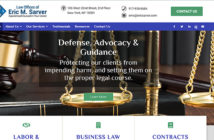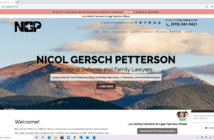Becoming a go-to media source has amplified the writing efforts of this high-profile and accomplished Texas patent attorney.

Some law firms might dismiss blogging as a waste of time, not understanding how the continual stream of updates and information could possibly make a difference for the firm. But blogging can be an effective marketing tool.
Michael C. Smith, an attorney from Marshall, Texas who is a partner at Siebman, Burg, Phillips & Smith, LLP (http://www.siebman.com/), uses blogging in conjunction with three other marketing tactics to build credibility and referrals. His four-fold approach involves:
- Blogging
- Networking
- Authoring legal resources and articles
- Developing relationships with reporters
Smith’s four-fold approach, along with his distinguished career, has established him as a premier expert on patent litigation in the Eastern District of Texas.
Background
Smith specializes in helping firms with federal court litigation in the Eastern District of Texas, particularly patent litigation. Attorneys frequently refer clients to him or bring him in as local counsel for their cases. Establishing his credibility through a long history of court successes, along with a highly popular professional blog, helps earn his referrals.
“When I’m working on a case and there are 20 other lawyers in the group, and I say, ‘This is what I’ve seen this judge do,’ I’ve got enormous credibility,” he said. “People want to know what I think about legal situations.”
Smith’s blog is hugely popular because he writes about the biggest patent litigation district in the United States – a patent litigation district that he helped develop.
“The Eastern District is the number one district in the country in terms of patent litigation,” he said. “1,500 cases were filed here last year.”
Blogging to 700 Hits a Day
Smith always understood the importance of having a web presence. But getting other people to recognize that importance was sometimes a struggle.
“I started my blog in September 2003 when I got very frustrated with the firm I was at because I couldn’t get them to put a website up,” Smith recalled. “Even with the internet still just starting, you had to have a presence on the web.”
He wanted to get the word out online about who he was and what he did, especially with patent litigation being new to the Eastern District at the time.
“I was the chair of the local rules committee, the ‘rules guru’ for the district,” he said. “I decided that I should start posting about developments and get to be known as the guy who knows what’s going on in this court.”
He started two blogs. One is a personal blog called “Puttering in the Study.” His professional blog focuses on federal court practices in the Eastern District of Texas, called EDTexweblog.com. Today, the blog gets about 700 hits a day.
“An enormous number of people tell me that they read it, from judges to people in the patent office,” he said.
Locating a good web developer wasn’t easy back in 2003. So Smith needed to figure out how he could create his own web presence that he could personally manage. He decided that blogging was the best bet. Originally, he started out with a longer name for his blog. But a web designer advised him that a one-word name has better traction and is easier for people to remember. So he shortened his Eastern District of Texas blog to one word: EDTexWeblog.

Smith’s blog design is simple, with the focus being on the content rather than the design. He simply has a header on top with the title of the blog and his name. The rest of the blog has content-heavy posts with a few photos interspersed throughout. He also lets visitors sign up for email updates.

Over time, Smith’s blog grew in popularity. He didn’t pay to advertise it online or use Google AdWords. He just let the blog grow organically, posting links to his updates on LinkedIn and a few other sites. His unique content is what drew people in and helped it grow.
Advice for New Bloggers
Smith’s key piece of advice for writing a legal blog is to keep the content opinion-neutral. Find a way to stand out that doesn’t involve controversy.
“A few years ago, a guy who was virulently anti-patent troll had an anonymous blog called Troll Tracker,” he said. “It had flaming rhetoric.”
When the attorney’s identity was unearthed, he suffered major repercussions.
“It eventually got him fired and his firm sanctioned,” Smith said. “It wasn’t because of his opinions, but because he wrote in a way that was very offensive to a lot of people.”
Smith uses a different tactic that is light on controversy but heavy on valuable information.
“When I post about cases, I don’t say ‘this is good’ or ‘this is bad,’” he said. “It’s just a basic page on what happened in the case. I’ve said negative things when people are negative about the district, but I don’t say negative things about a case.”
He also uses carefully placed humor to develop a unique tone. This lighthearted humor helps his blog stand out from the dry legal writing that judges and attorneys are used to seeing.
“I try to be, not sarcastic, but witty,” Smith said. “I make it kind of funny and come up with puns about cases or historical references. I’ve had law clerks and judges tell me that they get so much overblown rhetoric, they really enjoy reading something with a bit of wit.”
His tactic has brought him a lot of attention.
“The other day I was emailing some lawyers from Puerto Rico who had never had a case in the Eastern District before,” Smith said. “I get an email from one of them: ‘By the way, I just figured out who you are. I love your weblog!’ Another time, I’m at a hearing and an associate across the table looks over and says, ‘You’re the one with the weblog. It’s an honor to meet you.’”
When a marketing team did a study for Smith’s law firm, they told him that they’d never seen an attorney’s blog get as much positive reception as his does.
Always Keep Your Networking Face On
Smith credits much of his marketing success to strong networking that later brought him referrals. Whether he’s working with an attorney or facing someone as opposing counsel, he makes it a personal rule to treat the other person with respect.
“I get a lot of cases from former opposing counsel,” he said. “The other side will see how much I’m able to help out my guys compared to what they’re getting from their person, and so the next time they get a case, they call me. It’s a high compliment.”
He said one key is avoiding the drama that other attorneys might get pulled into.
“Even when the lead counsel is screaming at another’s lead counsel, I don’t participate in that,” he said. “So I gain some credibility with them. It always pays to not be a jerk.”
Every encounter can be a potential networking opportunity.
“You never know when a law clerk will become a judge or a guy who was a judge ends up being on the other side of you in a case,” Smith said. “If there’s something bad to say about a lawyer, it’s going to come out… It’s important to always treat everyone you run into well.”
One motto to live by, he suggests, is choosing your battles.
“You don’t have to show up to every fight you’re invited to,” Smith said. “The other day, someone sent something out that riled up my co-counsel. I was thinking, like Mark Cuban has said, ‘This is just a hurricane in the urinal.’ I could’ve gotten pissed off and tried to argue him down. But this was something that was never going to matter. There were better things to do.”
Establishing Connections with Reporters
Smith is a frequently quoted source for reporters from local newspapers and even national publications. His expertise gives him a number of opportunities to get his name out in the public, which generates new clients and referrals. He’s been quoted by publications like The Dallas Morning News and even The Wall Street Journal and The New York Times. Each of these opportunities came from developing relationships and establishing a reputation for being an accessible expert in his specialization.

“You want to present yourself as an authority, so that when legal (and other) publications want to write on a subject, they call you and quote you,” he said. “You want to cultivate that. For years I didn’t realize how important that was.”
He’s taught seminars on IP litigation for the State Bar of Texas and classes on Eastern District patent rules for the American Intellectual Property Law Association. He’s been interviewed by journalists writing for print publications and blogs, along with reporters preparing televised news reports.
Establishing connections with reporters is important, because one reporter is often assigned to a specific beat and will go back to the same sources for future stories. If you make a good impression the first time, you’ll likely be contacted again.
“Certain stories they write over and over again and I’m on their short list,” he said.
Writing Go-To Resources
In addition to his blog, Smith writes frequently for magazines, journals and other publications. He also edits a federal court rule book called O’Connor’s Federal Rules. His publications help further establish the expertise and credibility he’s gained in the courtroom. This expertise is key to netting new referrals from attorneys. The more times people run into his name, the more likely they are to think of him when they need co-counsel or have a client with a need that he specializes in.

The topics he’s written range from product liability to federal law and procedural issues.
“I have one paper in Texas Lawyer this week that’s an analysis of patent verdicts in the district,” Smith said. “I also have an intellectual property magazine article about managing patent cases. At any given time I have four to five papers in various stages.”
He tries to write papers on topics that are useful but also unique, so he’ll stand out.
“I’m working on one now that’s a conglomeration of an analysis of something Galileo did, something Justice Scalia wrote from 15 years ago, something the Texas Legislature did, a ruling a local judge did a few years ago, and duck hunting,” he said. “That one will get some people’s attention!”
He boosts his publications and even his blog posts with frequent links on his Twitter page and his LinkedIn profile.
“When I post to my weblog, I’ll post a link on LinkedIn immediately and then cross post on Twitter,” he said.

He advises attorneys who use Twitter to be selective in who they follow.
“Some of my followers aren’t genuine people,” he said. “Some are just bizarre and trying to get their numbers up by following everyone they can. I only follow people in the legal area I’m in. You don’t want your account clogged up.”
How to Get Started
Pursuing the four marketing methods that Smith focuses on may feel overwhelming, but getting started is really not too complicated.
Writing Your Blog
The first step is to set up a blog. Keep it professional with a clean, simple design. Post about topics related to your practice, such as new rulings or laws. Post frequently and cross-post links to your work on social networking sites like LinkedIn, Twitter, Facebook, and Google+.
Your blog should “be a presence on the web saying here’s what we are and what we do,” Smith said.
Smith suggests finding a tone that will draw in readers while maintaining professionalism. He uses wit and puns to be entertaining, while being careful not to insult anyone.
“I try to show that I have expertise in an area that might be useful to people,” he said.
Remember that professionalism is of utmost importance, because you never know who might be reading your blog.
“We were at dinner with a federal judge and talked about an order he’d written,” Smith recalled. “And he suddenly said, ‘I really enjoy your weblog.’”
Submitting Papers to Journals and Magazines
If you want to build credibility by writing papers for journals and magazines, Smith has a few suggestions. First, don’t be concerned about the money you’ll make. Some reputable sources, like Texas Lawyer and Law.com, want contributors who’ll write for free.
There’s no sure fire way to get an article accepted. But once you start asking around, you’ll get on the editor’s radar. So first, think about a legal topic you have expertise in and would like to write about.
“Figure out what magazines you like to read and that you think (your article) would show up in,” he said. “Write them (the editors) and offer to write an article on that topic. You’ll get on their list of people that write in a certain field and they might call you when they need something.”
Working with Reporters
Being quoted in news articles is a great way to gain credibility and get your name out there in front of potential new clients. But it doesn’t happen overnight. Your blog can play a critical role in developing relationships with journalists.
Establish a Relationship
The main thing you should start out doing, Smith suggested, is posting on your blog right away whenever there’s a new development in your area of legal expertise. This can be a new law that’s been passed, a ruling with far-reaching implications, or even a comment by another attorney that’s gained prominent attention.
“I post on those subjects right away because I know reporters are reading the weblog,” he said. “They’ll even tell me, ‘We saw you posted on this new rule. What’s going on with that?’”
Of course, reporters likely won’t know about you or your blog until you tell them. You can’t just wait for search results on Google to point them to your website. Smith said that if he were starting over, he’d begin by researching which journalists report on his areas of law. He’d focus on local newspaper publications along with wider-reaching newspapers and magazines and make a list of reporters who cover the legal beat.
“Then I’d send them stuff they might be interested in,” he said. “I might say, ‘This ruling was just put out and will have this effect.’”
Although you can be straightforward and just tell a reporter that you’re available for interviews, you’ll likely get better results if you demonstrate that you’re a source of good information.
“My speculation is that once you get a good relationship with them (journalists), they know that if an article’s in your field, they can call you and have a good couple quotes. Or you’ll be able to tell them some other people to talk to, such as who are the other players and how everything fits together.”
Watch Out for Reporters with Agendas
Just as important as establishing the initial relationship is knowing how to handle your interviews. Always keep an eye out for reporters who have an angle in mind.
“When I get a leading question, I’m good enough at cross examining people, so I try not to give them something that would sound bad in isolation or out of context,” he said. “I don’t want to be seen as bad-mouthing the judges or the system.”
Remember to be selective in what stories you provide interviews for. Even if you’re saying something positive, just being quoted in a negative story can give you the wrong kind of attention.
“The problem with a story that bad mouths the system is that people are irritated that you gave the reporter any credibility, even if you just provided good background on the subject,” he said. “Get to know your audience and who you’re talking to. But be aware that you may be used to make a point that you don’t agree with. No one who watches your interview will realize that it might not be a fair and balanced representation of what you said.”



